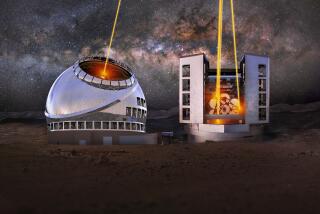An International Energy Frontier
When the superconducting super collider particle accelerator project was canceled three years ago, many physicists worried that it might have a contagious effect on the science policies of other countries. In December 1994, however, a consortium of European countries, making up the European Center for Nuclear Research voted unanimously to approve construction of a European super collider, the Large Hadron Collider, to be built at the center laboratory near Geneva.
A whole new layer of mystery about the fundamental laws of nature that applied to the early history of the universe is likely to dissolve when the Hadron becomes operational in the next decade. Highlights include the possible discovery and exploration of âsupersymmetry,â a sort of new quantum dimension of space time at which previous experiments have hinted, and the expected discovery of the mysterious âsymmetry breakingâ mechanism by which elementary particles get their masses. In particular, should supersymmetry be discovered, Hadron experimentalists, including a strong U.S. contingent, will have the challenge of unraveling and interpreting a structure whose richness and novelty has few rivals in the history of science.
The Hadron has a hefty construction price tag of $2.5 billion, still considerably less than the roughly $10 billion that would have been required for the superconducting super collider. The Hadron is cheaper because it will use existing facilities, notably the huge tunnel built for an existing center accelerator, and because the Hadron energy is considerably smaller than was the target of the superconducting super collider. The Hadron will, however, attempt to compensate for the lower energy by a higher âluminosityâ (or intensity of the particle beams) than the superconducting super collider was designed for. The physics potential of the Hadron will therefore be competitive, for most purposes, with that of the superconducting super collider.
Achieving the necessary high luminosity and working within the constraints of the existing tunnel make the Hadron in many ways an unusually demanding project technically, even compared with other particle accelerators. Technological frontiers are being pushed back in areas like magnets, high speed electronics, vacuum technology and cryogenics. So far, the project is being kept on schedule and within budget. Hadron cost estimates and timetables have been reviewed favorably by the U.S. Energy Department. Given the pressures on science budgets everywhere, any appreciable cost overrun would very likely endanger continuation of the project.
The guaranteed funding from the European countries would permit completion of the Hadron by the year 2008. Stretching out the construction schedule over so many years will delay physics and is wasteful in terms of dollars and cents. Prospects of accelerating the completion of the Hadron depend on making it into a truly worldwide project. So far, Japan, Russia, India, Israel and Canada have pledged contributions. The main remaining question mark is the U.S. role.
Scientifically, the choice seems clear. A U.S. contribution of half a billion dollars or more over the next decade should be the top priority for U.S. high energy physics, even if the funds must be squeezed from other parts of the program. In participating in the Hadron, the U.S. would join a truly exciting project with many technical challenges and a fair chance of really epochal discovery. Participation in this project would enable U.S. laboratories and industry to maintain an enhanced level of technological capability, with benefits for other projects. It also would enable us to recoup much of the superconducting super collider investment in particle detectors, which is largely transferable to the Hadron.
And finally, a lesson that many of us learned from the collapse of the superconducting super collider is crucial here. In the future, big science will have to be international. Because so many components are already in place, because of the comparatively modest contribution sought from the U.S. and because of the fundamental nature of the science involved, the Hadron is a pretty good test case of whether worldwide big science is possible. The U.S. would be poorly placed in future discussions of big science projects if we drop the ball now.






